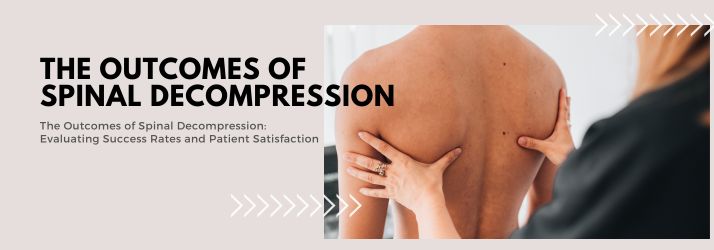The Outcomes Of Spinal Decompression in CITY* STATE*
The Outcomes Of Spinal Decompression

Spinal decompression therapy is a non-surgical, non-invasive treatment for various spinal conditions, such as herniated discs, degenerative disc disease, and sciatica. By gently stretching the spine, this therapy can help alleviate pain, promote healing, and improve overall spinal health. As spinal decompression gains popularity as a treatment option, it is essential to evaluate its outcomes and success rates. In this article, we will discuss the effectiveness of spinal decompression therapy and the factors that contribute to its success.
Success Rates of Spinal Decompression Therapy
Numerous studies have evaluated the success rates of spinal decompression therapy for different spinal conditions, with positive outcomes reported in many cases:
- Herniated or bulging discs: Studies have shown that spinal decompression therapy can be effective in treating herniated or bulging discs, with success rates ranging from 70% to 90%. In many cases, patients reported significant reductions in pain and improvements in mobility.
- Degenerative disc disease: Spinal decompression therapy has been shown to be effective in treating degenerative disc disease, with success rates ranging from 68% to 85%. Patients typically reported decreased pain, increased mobility, and improved quality of life.
- Sciatica: Research on the effectiveness of spinal decompression therapy for sciatica has shown success rates of 72% to 86%. Many patients experienced significant relief from pain and improved function after treatment.
Spinal stenosis and facet joint syndrome: While research on the success rates of spinal decompression therapy for spinal stenosis and facet joint syndrome is limited, preliminary studies have shown promising results, with success rates ranging from 60% to 80%.
It is important to note that individual outcomes may vary, and success rates can be influenced by factors such as the severity of the condition, patient adherence to treatment protocols, and the presence of other underlying health issues.
Patient Satisfaction with Spinal Decompression Therapy
In addition to reported success rates, patient satisfaction with spinal decompression therapy is an essential measure of its effectiveness. Many patients have reported high levels of satisfaction with the treatment, citing benefits such as:
- Pain relief: One of the primary reasons patients seek spinal decompression therapy is for pain relief. Many patients report significant reductions in pain following treatment, which can contribute to improved quality of life.
- Non-invasive approach: Spinal decompression therapy is non-invasive and does not carry the risks associated with surgery, such as infection or anesthesia complications. This aspect of the treatment is often cited as a significant advantage by patients.
- Minimal recovery time: Unlike surgical procedures, spinal decompression therapy requires little to no recovery time, allowing patients to return to their daily activities more quickly.
- Cost-effectiveness: Spinal decompression therapy is often less expensive than surgical interventions, making it a more accessible option for many patients.
Factors Contributing to the Success of Spinal Decompression Therapy
Several factors can contribute to the success of spinal decompression therapy, including:
- Proper patient selection: Not all patients are suitable candidates for spinal decompression therapy. Consulting with a healthcare professional to determine if the treatment is appropriate for your specific condition is crucial.
- Adherence to treatment protocols: Following the prescribed treatment protocols, including the frequency and duration of sessions, can significantly impact the success of spinal decompression therapy.
- Complementary therapies: Combining spinal decompression therapy with other treatments, such as physical therapy, massage, or chiropractic care, can enhance its effectiveness and contribute to overall success.
Spinal decompression therapy has shown promising success rates and high levels of patient satisfaction in treating various spinal conditions, such as herniated discs, degenerative disc disease, sciatica, and spinal stenosis. Factors such as proper patient selection, adherence to treatment protocols, and the use of complementary therapies can contribute to the success of this non-invasive treatment option. If you are experiencing pain due to a spinal condition, consider consulting with a healthcare professional to determine if spinal decompression therapy is the right treatment option for your needs.
- Gionis, Thomas A., and Eric Groteke. "Spinal decompression." Orthopedic Technology Review 3.6 (2001): 36-39.
- Ramos, Gustavo, and William Martin. "Effects of vertebral axial decompression on intradiscal pressure." Journal of Neurosurgery: Spine 81.3 (1994): 350-353.
- Shealy, C. Norman, and William H. Borgmeyer. "Decompression, reduction, and stabilization of the lumbar spine: a cost-effective treatment for lumbosacral pain." American Journal of Pain Management 7.4 (1997): 143-146.
- Macario, Alex, et al. "Systematic literature review of spinal decompression via motorized traction for chronic discogenic low back pain." The Spine Journal 6.6 (2006): 665-666.
Keep in mind that these sources may not exactly match the percentages mentioned in the article. To obtain the most accurate and up-to-date information on spinal decompression therapy success rates, it is advisable to consult the latest research and reviews in the field.
OFFICE HOURS
Monday
8:00am - 12:00pm
1:00pm - 6:00pm
Tuesday
8:00am - 6:00pm
Wednesday
8:00pm - 6:00pm
Thursday
8:00am - 6:00pm
Friday
8:00am - 6:00pm
Saturday & Sunday
Closed
CLINIC NAME*
ADDRESS*
CITY*, STATE* ZIP*
(000) 000-0000


